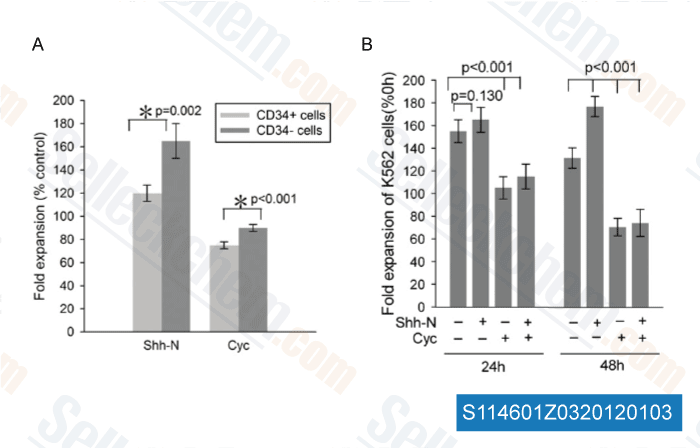|
Toll Free: (877) 796-6397 -- USA and Canada only -- |
Fax: +1-832-582-8590 Orders: +1-832-582-8158 |
Tech Support: +1-832-582-8158 Ext:3 Please provide your Order Number in the email. |
Technical Data
| Formula | C27H41NO2 |
|||
| Molecular Weight | 411.62 | CAS No. | 4449-51-8 | |
| Solubility (25°C)* | In vitro | Ethanol | 4 mg/mL (9.71 mM) | |
| DMSO | Insoluble | |||
| Water | Insoluble | |||
|
* <1 mg/ml means slightly soluble or insoluble. * Please note that Selleck tests the solubility of all compounds in-house, and the actual solubility may differ slightly from published values. This is normal and is due to slight batch-to-batch variations. * Room temperature shipping (Stability testing shows this product can be shipped without any cooling measures.) |
||||
Preparing Stock Solutions
Biological Activity
| Description | Cyclopamine (11-deoxojervine) is a specific Hedgehog (Hh) signaling pathway antagonist of Smoothened (Smo) with IC50 of 46 nM in TM3Hh12 cells. | ||
|---|---|---|---|
| Targets |
|
||
| In vitro | Cyclopamine inhibits the Hedgehog signaling pathway with an IC50 of 46 nM, and blocks the activity of human Smo receptor expressed in CHO-K1 cells in [3H]Hh-Ag binding assay with an IC50 of 280 nM. [1] This compound significantly inhibits Hedgehog pathway activity in a dose-dependent manner in gut-derived tumor cell lines expressing Patched (PTCH) mRNA, and induces growth inhibition of those tumor cell lines by 75-95% at the concentration of 3 μM, but ineffective towards the colon tumor cells without PTCH mRNA expression, suggesting the effects of this chemical treatment are Hedgehog pathway related rather than generally cytotoxic. [2] By blocking Hedgehog signaling through direct interaction with Smo, it (10 μM) inhibits the proliferation of SMOhigh Cyclopamine-responsive cell lines L3.6sl and Panc 05.04 by 75-80%, and increases the apoptosis by 2.5- to 3.5-fold, without affecting the BxPC3-SMOlow cell line. [3] This treatment significantly decreases of Snail mRNA and increasea E-cadherin transcripts in the E3LZ10.7 cell line. Independent of inhibition of cell growth, it significantly inhibits the invasive phenotype of Hedgehog-dependent L3.6pl cells, causing a >500-fold reduction in the number of transmigrating cells, but not that of the Hedgehog-independent cell line Panc-1. [4] | ||
| In vivo | Administration of Cyclopamine at dose of 50 mg/kg/day for 22 days eradicates the HUCCT1 xenografts in mice with no obvious adverse effects. [2] This compound treatment at dose of 1.2 mg for 7 days induces significant apoptosis of tumor cells and decreases the tumor mass by 50-60% in Panc 05.04- and L3.6sl-derived tumors, respectively, but not in the BxPC3-SMOlow tumors. [3] Administration of this chemical alone profoundly inhibits tumor metastases in xenografts of E3LZ10.7 and L3.6pl, and completely abrogates metastases when in combination of gemcitabine. [4] |
Protocol (from reference)
| Kinase Assay:[1] |
|
|---|---|
| Cell Assay:[2] |
|
| Animal Study:[2] |
|
References
|
Customer Product Validation
![<p>(A)[3H]thymidine incorporation assay of B16F10 melanoma cells treated with DMSO or cyclopamine after incubation with SA-CM from WT and Cav1KO dermal fibroblasts. Representative phase-contrast images of B16F10 cells treated with SA-CM from WT and Cav1KO fibroblasts with cyclopamine are shown on the right. Similar experiments (B) were done with A-375 cells incubated with SA-CM from hTBJ1-shCtrl and hTBJ1-shCAV1 cells.</p>](https://file.selleckchem.com/downloads/review/700px/Cyclopamine-S114601Z0220120306.gif)
-
Data from [ Cancer Res , 2012 , 72, 2262-74 ]

-
Data from [ Cancer Lett , 2012 , 322, 169-176 ]

-
Data from [ Exp Hematol , 2012 , 40, 418-27 ]

-
, , Dr. Yong-Weon Yi from Georgetown University Medical Center
Selleck's Cyclopamine Has Been Cited by 153 Publications
| The O-glycosyltransferase C1GALT1 promotes EWSR1::FLI1 expression and is a therapeutic target for Ewing sarcoma [ Nat Commun, 2025, 16(1):1267] | PubMed: 39894896 |
| PlexinD1 is a driver and a therapeutic target in advanced prostate cancer [ EMBO Mol Med, 2025, 17(2):336-364] | PubMed: 39748059 |
| PPARG contributes to urothelial integrity in the murine ureter by activating the expression of Shh and superficial cell-specific genes [ Development, 2025, 152(8)dev204324] | PubMed: 40167323 |
| Interplay of SHH, WNT and BMP4 signaling regulates the development of the lamina propria in the murine ureter [ Development, 2025, 152(3)DEV204214] | PubMed: 39817691 |
| SHH Pathway Inhibition and Astrocyte Co-culture Induce Distinct Responses in Glioblastoma and Cancer Stem Cells [ Res Sq, 2025, rs.3.rs-7214243] | PubMed: 40894044 |
| Proximity based proteomics reveals Git1 as a regulator of Smoothened signaling [ bioRxiv, 2025, 2025.01.06.631593] | PubMed: 39829937 |
| Foxo3-mediated physiological cell competition ensures robust tissue patterning throughout vertebrate development [ Nat Commun, 2024, 15(1):10662] | PubMed: 39690179 |
| Phosphorylation of human glioma-associated oncogene 1 on Ser937 regulates Sonic Hedgehog signaling in medulloblastoma [ Nat Commun, 2024, 15(1):987] | PubMed: 38307877 |
| Establishment, characterization, and biobanking of 36 pancreatic cancer organoids: prediction of metastasis in resectable pancreatic cancer [ Cell Oncol (Dordr), 2024, 10.1007/s13402-024-00939-5] | PubMed: 38619751 |
| Transcription of microRNAs is regulated by developmental signaling pathways and transcription factors [ Front Cell Dev Biol, 2024, 12:1356589] | PubMed: 38721525 |
RETURN POLICY
Selleck Chemical’s Unconditional Return Policy ensures a smooth online shopping experience for our customers. If you are in any way unsatisfied with your purchase, you may return any item(s) within 7 days of receiving it. In the event of product quality issues, either protocol related or product related problems, you may return any item(s) within 365 days from the original purchase date. Please follow the instructions below when returning products.
SHIPPING AND STORAGE
Selleck products are transported at room temperature. If you receive the product at room temperature, please rest assured, the Selleck Quality Inspection Department has conducted experiments to verify that the normal temperature placement of one month will not affect the biological activity of powder products. After collecting, please store the product according to the requirements described in the datasheet. Most Selleck products are stable under the recommended conditions.
NOT FOR HUMAN, VETERINARY DIAGNOSTIC OR THERAPEUTIC USE.
